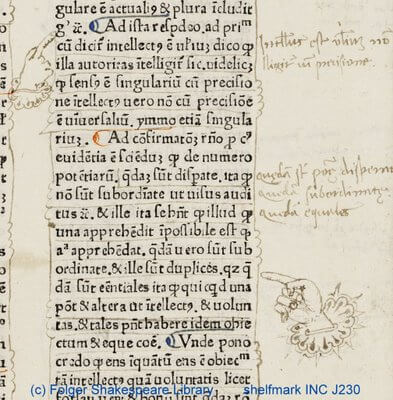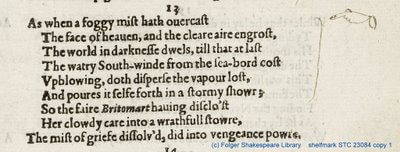A quick but important announcement first: I am hosting the next early modern edition of Carnivalesque. Please nominate your favorite early modern blog posts by using the Carnivalesque nomination form, commenting here, or by emailing me directly (you can find my email address through my profile). The no-holds-barred Carnival fun and wisdom is scheduled for publication on March 21st, so get me pointed in the right direction now!
And that last bit is my not very subtle transition to the lovely pictures below. I promised my last commenter that I would follow up that great pointing forefinger (or Fonz’s thumb, depending on your tastes) with some more examples. So here’s another great set of pointing fingers, this time complete with fancy ruffles. This is from a 1475 commentary on Aristotle–again, more commentary on commentary, as we saw with the Boethius. Some genres of writing would seem to invite more pointing notes than others. Here we’ve got not only the fists, but annotations and brackets. In fact, nearly the entire text on this page is marked off with brackets. (Zoomable image; catalogue entry)
I’ve been calling these images fists, which is how they tend to be identified in the Folger’s catalogue. But as Sherman discusses, there is no standardized language for this image, even as we tend to instinctively understand what it is that the pointing finger is doing:
I have now found no fewer than fifteen English names for what I prefer to follow the manuscript specialists in calling the manicule: hand, hand director, pointing hand, pointing finger, pointer, digit, fist, mutton fist, bishop’s fist, index, indicator, indicule, maniple, and pilcrow.
I can’t do justice to his insights here, but it’s worth reading Sherman’s piece to think about the ways in which the very word that we use to describe this mark makes distinctions between origins in manuscript and print and suggests the various ways in which the mark is used to organize the text, the hierarchy of authorities governing it, and readers’ responses to it. Go forth and read!
In the meantime, I leave you with a less fanciful manicule, one that doesn’t provide a commentary on commentary, but that marks out a somber and beautiful passage from Spenser’s Faerie Queene (image; catalogue):


>Just a note to point out (bwaaa haaa!) that “fists” is used in more than just the Folger’s library catalogue. “Fists” is the preferred term chosen by the Controlled Vocabularies subcomittee of the Bibliographic Standards Committee of RBMS (the Rare Books and Manuscripts section of the American Library Association). If the online catalogue is set up with full cross-referencing, searching on one of the other terms would bring up a “See FISTS” link to click on.
>Good point, Lorem Ipsum. I haven’t talked about the actual process of cataloguing in this blog (largely because I’m not a cataloguer!) but it does have a controlled vocabulary. For those of you who are curious, there’s a great set of online resources maintained by the RBMS Bibliographic Standards Committee at http://lib.nmsu.edu/rarecat/ and I visit it often when I need help deciphering cataloging jargon or am looking for further information in the field of rare books.One other nice point about “fists” that Sherman makes: it’s actually a term that derives from printers’ slang, and thus refers more properly to the printed fists that we find in texts (like in the post from a few weeks ago). A hand-drawn hand is a different creature. Sherman’s preferred term, “manicule,” comes from the Latin maniculum, meaning “a little hand.” I tend to still refer to them as fists, though I almost always make a hand gesture modeling the pointing finger when I say it–even when I’m blogging.
>Fellow lovers of the gentle fist in all its manifestations might enjoy this group devoted to sightings in the wild: http://www.flickr.com/groups/manicule
>Manicules in the wild–thanks for that!